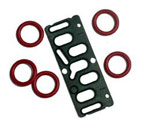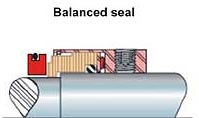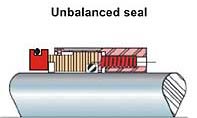
|
7108
S. Alton Way, Unit I |
(303) 758-2728
Home > Mechanical Seal Classification > Pusher Type
Classification of Mechanical Seals
Classification by pusher vs. non-pusher and balanced vs. non-balanced
Pusher vs. Non-pusher
Pusher seals utilize a dynamic secondary seal which moves axially with the major seal face. Non-pusher seals have a static secondary seal which stays stationary against the shaft or sleeve.

Defined by the secondary seal type: o-ring or polymer wedge versus bellow, rubber or metal.
Application fields of each type overlap.
Most apparent distinction is the pressure limit.
Acquisition cost can vary widely.
Balanced vs. Unbalanced
|
Reduced closing forces Reduced power consumption For pressure up to 3000 psig Always recommended for volatile liquids |
High closing forces Low leakage For pressure up to 200 psig Not recommended for volatile liquids |
Next: Classification by face patterns
We are located in the Denver Technological
Center in a suburb of Denver, Colorado
©1997-2017, Problem Solving Products, Inc.
Website Map | Privacy Statement
| Terms of Use



